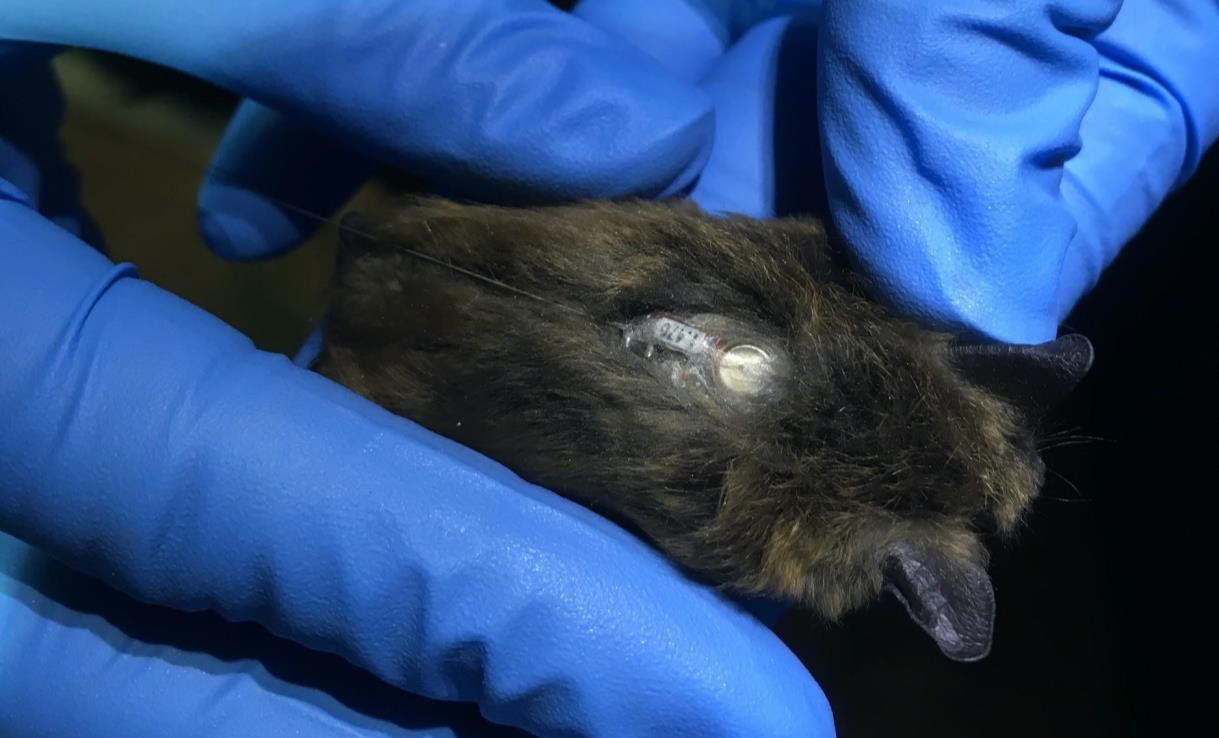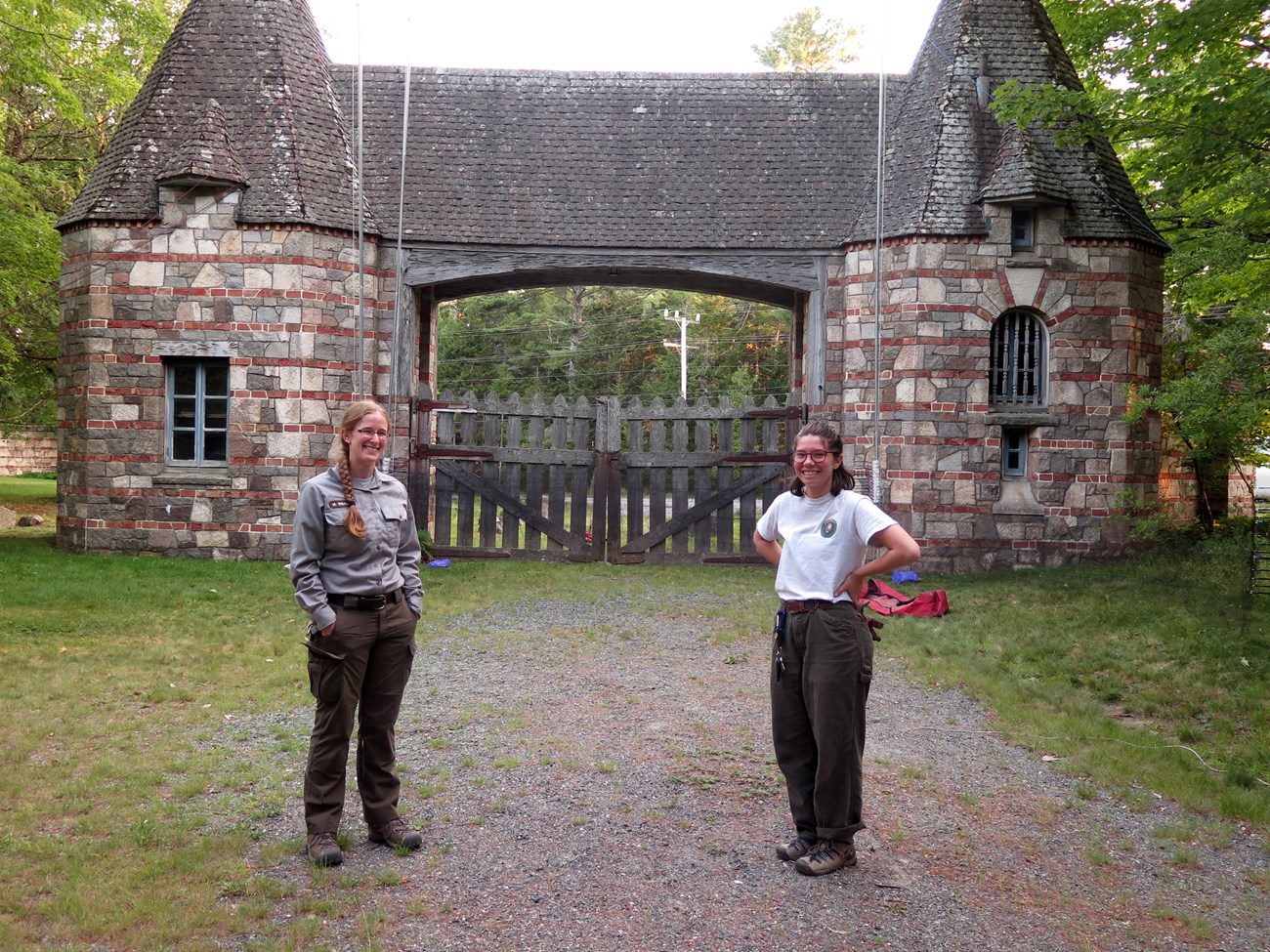Last updated: March 8, 2025
Article
Preserving Historic Buildings That Bats Call Home
Acadia National Park is going to restore its historic Rockefeller gatehouses. Here’s how we’ll protect the imperiled bats that live there.
By Bik Wheeler, Morgan Ingalls, Lara Wilbur, and Molly Donlan

Image credit: NPS / Morgan Ingalls
Iconic American financier John D. Rockefeller, Jr., built the Jordan Pond and Brown Mountain gatehouses at Acadia National Park in 1932. He placed them at the entrances to his estate’s carriage roads on Mount Desert Island off Maine’s rocky coast. American architect Grosvenor Atterbury designed the stone and half-timbered buildings with a nod to historic French architecture, creating a unique “Acadian” design style.
Both gatehouses need extensive masonry rehabilitation, but they are also home to three vulnerable species of Myotis (“mouse-eared”) bats. Bat populations have declined by the millions in North America since the emergence of white-nose syndrome, a devastating disease. The National Park Service’s mission tasks the agency with protecting these buildings and the imperiled creatures that roost in their nooks and crannies. How can we reconcile these two seemingly competing goals?
Myotis bat populations are especially vulnerable to white-nose syndrome, because they don’t have many pups. Each female gives birth to only one pup per summer, and many of the pups die. Some Myotis bats use communal maternity roosts where females can safely raise their young until they become independent and able to find food on their own. Roosts with multiple bats are especially important to bat reproductive success, as the presence of adult females both increases the temperature of the roost and allows them to cooperate in caring for pups. In northern latitudes such as Maine, buildings may be especially important to bats. This is because the insulating properties and myriad cracks and crevices of the buildings create warm, dark, sheltered spaces for maternal bats to raise their young.

Image credit: NPS / Morgan Ingalls
In order to proceed with restoring the gatehouses, we needed more details about how the bats are using them. Both gatehouses are used by bats and are similarly constructed. We had more records of species and individuals using the Brown Mountain Gatehouse, so our study focused on that gatehouse. Our results also apply to the Jordan Pond Gatehouse.
In 2014 to 2019, we captured bats and attached very high frequency radio transmitters to them. This allowed us to track the bats to roosts in trees, rock cliffs, and buildings, including the Brown Mountain Gatehouse. We used radiotelemetry, infrared cameras, mist net surveys, and other techniques to determine when the bats were using the gatehouse and in which parts of the building.
We used hand-held lights and a GoPro camera mounted on a pole to search for daytime resting areas (day roosts) and to count the number of bats using each roost. During the evening, we used video cameras with infrared spotlights and acoustic echolocation detectors to pinpoint emerging bats. We also measured the temperature, humidity, and barometric pressure of the roosts.
We documented bats using Brown Mountain Gatehouse during five separate years: 2014, 2016, 2017, 2018, and 2019. Over these five years, we fitted nine individual female bats with radio transmitters, which helped us find five major areas of the building that bats use as day roosts, including the roofs and the two towers.

Image credit: NPS / C. Heilakka
In 2019, we added passive infrared trigger cameras and mist nets to our survey methods. Although we had captured bats in the general vicinity before, this was the first year we set up mist nets close to the gatehouse. This helped us determine that bats were using specific areas of the gatehouse where they had roosted in previous years. We also noted how they were using these roosts and how many bats were present.
The camera traps showed us that the inner walls and ceiling between the gatehouse’s two towers were important places for bats to roost at night to avoid bad weather and predators. Night roosts were protected from rain but exposed on the bottom approximately 15 feet off the ground. In contrast to the exposed night roost, we found that all day roosts were completely enclosed under the clay roof tiles covering the buildings. We found no evidence of bats using the interior of the buildings for either day or night roosts.
Since 2016, we have documented reproductive females and juvenile bats using these roosts for all three of Acadia’s Myotis species. During the 2019 summer alone, we saw all three species using several different parts of the Brown Mountain Gatehouse complex. Other researchers have documented solitary bats of different species sharing roosts and maternity colonies of same-species Myotis bats using historic buildings. But it is highly unusual to have three species of maternal Myotis bats concurrently using the same building.

Image credit: NPS
Our work showed that Brown Mountain Gatehouse has optimal environmental conditions as determined by prior studies of Myotis maternity roosts. Most importantly, since bat pups need high temperatures, the roost was warmer than the ambient outside temperature both during the day and at night. Temperatures in the roost were far warmer than outside even when it was cloudy. These favorable environmental conditions help the bats successfully raise their young. Myotis bats have high site fidelity (they like to use the same site year after year), so conserving a productive maternity roost is extremely important for these imperiled animals.
Based on our studies, we recommended that the park rehabilitate the Acadia gatehouses in a way that preserves the thermal and spatial features of the roosts. For example, the clay tiles that cover the Brown Mountain Gatehouse roof warm up during the day and retain heat at night, making the crevices around the tiles prime bat habitat. In 2022, the National Park Service’s Historic Preservation Training Center will replace and repair the clay tiles with in-kind materials that have the same ability to gain heat during the day and hold it overnight. They will install the tiles on the roof with nails instead of cementing them into place with mortar. This historic installation technique will preserve the spaces beneath the tiles that roosting bats use. Since bats primarily use this structure during the active pupping season, the preservation team will refrain from working on the gatehouses from May 15 to September 30.
"Preservation combined with conservation often offers unique opportunities to solve complex problems.”
Jen Leeds is a historical architect at the Historic Preservation Training Center. “From a preservation standpoint, we want to return the gatehouses to good condition but realize that the design of the buildings has allowed for natural habitats to form,” she said. “The preservation techniques we use must consider these challenges to preserve both the buildings and its associated natural resources. Preservation combined with conservation often offers unique opportunities to solve complex problems.”
After several years of monitoring Myotis bats at Brown Mountain Gatehouse, we’ve determined that the spaces between the clay tiles on the roofs of the entire structure (carriage house, main building, walls, and towers) are not only prime roosting habitat but also maternity roosts for three different bat species. We do not think that bats are using the interior of the buildings, or if they are, they aren’t using it at the same rate as the exterior. This means that excluding bats from building interiors will decrease the chance of interaction between humans and bats and will not negatively affect the Brown Mountain Gatehouse bat community. We’ve also determined that bats primarily use these exterior roosts during the active season, so any work done on this historic structure during the winter is unlikely to affect these species.
We have a unique opportunity to protect populations of all three Myotis bat species at once by choosing the right construction techniques during the gatehouse rehabilitation. Rehabilitating historic buildings such as the Brown Mountain Gatehouse also ensures that these maternal roosting spaces will be available for bats in the future. We see bats and historic sites as potential allies, not competitors. Problems like this give us a chance to preserve our cultural heritage and conserve our imperiled wildlife.
About the authors

Bik Wheeler is the lead wildlife biologist at Acadia National Park. He works to conserve the park’s wildlife populations through monitoring and research. Bik delights in the diversity of animal behavior, particularly when populations use unexpected life history strategies. Image © Friends of Acadia National Park / W. Greene

Morgan Ingalls holds a Bachelor's degree in biochemistry from Marlboro College and a Master's degree in environmental studies with a focus on conservation biology from Antioch University New England. She is a biological technician at Acadia National Park where she studies remnant populations of Myotis bats and how they use park lands. Image © Friends of Acadia National Park / Julia Walker Thomas
Lara Wilbur worked at Acadia National Park as a biological science technician between 2016 and 2020. She primarily researched bats and bumblebees at the park. Lara is currently a Master's student at the University of Maine, Orono, researching a minnow species of special concern, the bridle shiner. She is using both traditional fisheries techniques and environmental DNA (eDNA) to survey water bodies for bridle shiners and to develop long-term monitoring strategies for the species in Maine.
Molly Donlan began assisting with bat monitoring at Acadia National Park as an Acadia Scholar in 2019. She continues to study wildlife in the park as a biological science technician.
